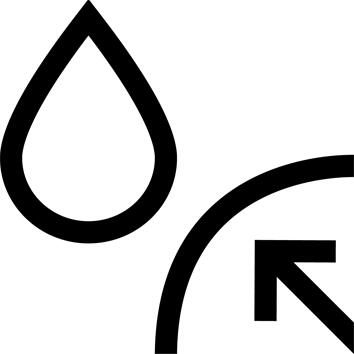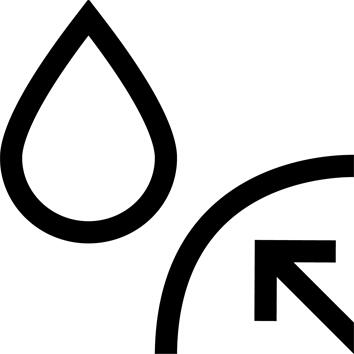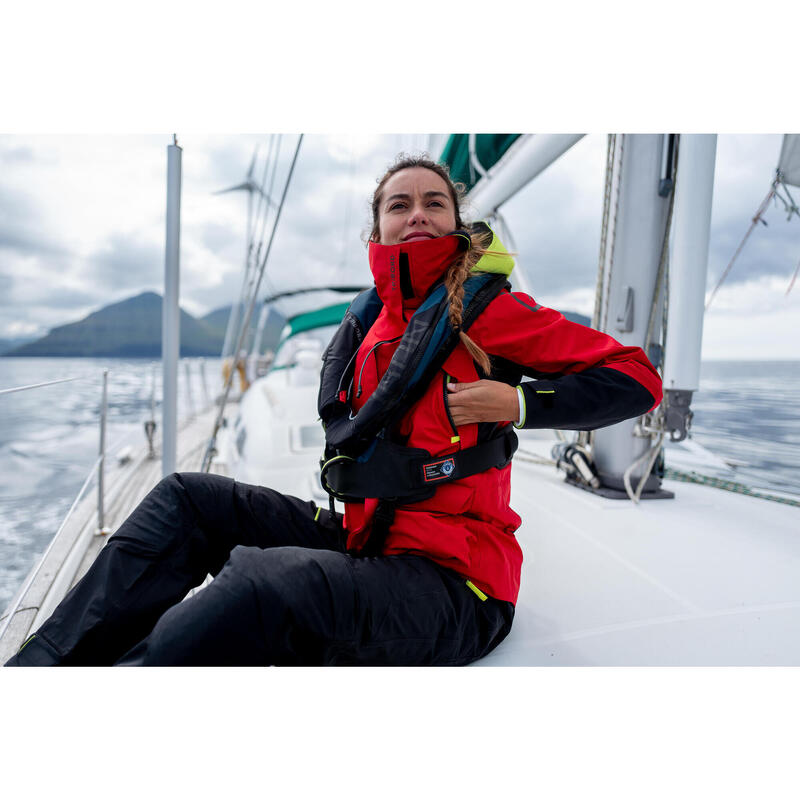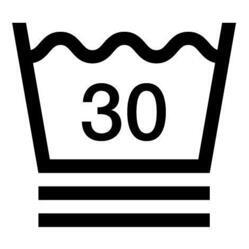What is the waterproofing level?
The fabric is constructed with a 3-layer membrane, resistant to a water pressure of 30000 mm Schmerber before and after 5 washes (test based on JIS standard). The higher the pressure, the more waterproof the fabric.
The product has been tested under a storm rain simulator, reproducing a rainfall of 450 mm/h (450 L/M²/h) for 24 hours (3x8 hours).
Waterproof jacket
- Fabric-covered neoprene sleeves limit water ingress.
- Seams are 100% taped.
- A rigid visor is integrated for added protection.
- Wind/wave skirt inside the jacket. Snap closure. This closure prevents splashes of water from seeping between the jacket and overalls.
What is water repellency and how do I maintain it?
Fabrics and fastenings are water-repellent.
The water repellency of a fabric is its ability to let water slide off its surface without absorbing it.
This means your jacket won't become waterlogged, remaining light and breathable. Water repellency is obtained by a treatment (DWR) applied to the outer face of the fabric, but these properties can be altered with use.
Water repellency can be reactivated by placing the jacket (previously air-dried) in the tumble-dryer for 10 minutes at low temperature.
Breathability
To determine whether a fabric is breathable, we measure its evaporative resistance, known as RET (test based on ISO 11092 standard). This is the fabric's capacity to let the water vapor produced by the body during exercise escape to the outside.
To determine whether a fabric is breathable, we measure its RET evaporative resistance (ISO 11092 standard). The lower the resistance, the more water vapor escapes from the fabric, making it more breathable.
The RET of this product is 25.
Weight
The jacket weighs 1027 grams in size M
Double sleeve
Double sleeve:
- An adjustable neoprene section in a soft, comfortable fabric on the inside to prevent untimely water ingress.
- An outer sleeve in waterproof fabric, adjustable with Velcro to protect the neoprene and provide maximum waterproofness.
Tip: if you wear mittens or gloves, insert them between the 2 sleeves for greater comfort and to prevent water ingress by capillary action.
Pockets
The jacket has 5 pockets:
- 2 hand-warmer pockets, under the chest and closed with YKK AquaGuard® zips
- 2 cargo pockets at waist level
- 1 pocket secured under the flap with a YKK AquaGuard® zip
Pockets are equipped with a drainage system to allow water to drain away.
Abrasion resistance
The jacket is reinforced at the buttocks for enhanced abrasion resistance.
Enough to dry your jacket.
A webbing loop lets you hang your jacket on a hook or coat rack for drying.
How to choose your jacket size?
The product is loose-fitting. Designed to be worn with thermal underwear and fleece underneath.
Choose your usual size.
How to care for your jacket
After use, rinse thoroughly with clean water to remove salt. Machine-wash about once a year to prevent the scratches from damaging the fabric during washing.
Dry in a well-ventilated area. Caution: never dry your jacket directly on a radiator.
If the water-repellency is less effective, you can occasionally tumble-dry it at low temperature for 10 minutes to reactivate the water-repellency.
How to wash your jacket Step 1
Close all zips and flaps. Also remember to loosen straps and elastic parts (hood) and empty pockets.
Then turn garment inside out to wash inside out.
How to wash your jacket Step 2
You can wash your jacket on a synthetic program at 30° with your usual detergent. Do not use fabric softener, which could damage the garment's original performance, and of course do not use bleach.
Make sure you don't fold your jacket too much when you put it in the washing machine, and limit the load.
Very important: select a thorough rinse or double rinse to remove all detergent residues.
How to reactivate water repellency?
Drying is essential to reactivate the water-repellent treatment.
We recommend that you let your jacket dry completely in the open air, flat on a drying rack. Never dry your jacket directly on a radiator or in direct sunlight.
Then tumble-dry on the synthetic program for a short time, i.e. 10 to 15 minutes, before putting it back on. Be careful not to over-dry the garment.
What's the difference between a vareuse and a veste de quart?
The jacket is ideal for maneuvering at the front of the boat (positions 1 and 2), and its half-zip provides extra protection in extreme conditions.
On the other hand, the jacket is more suitable for less exposed positions, and its zipper makes full opening quick and easy.


















